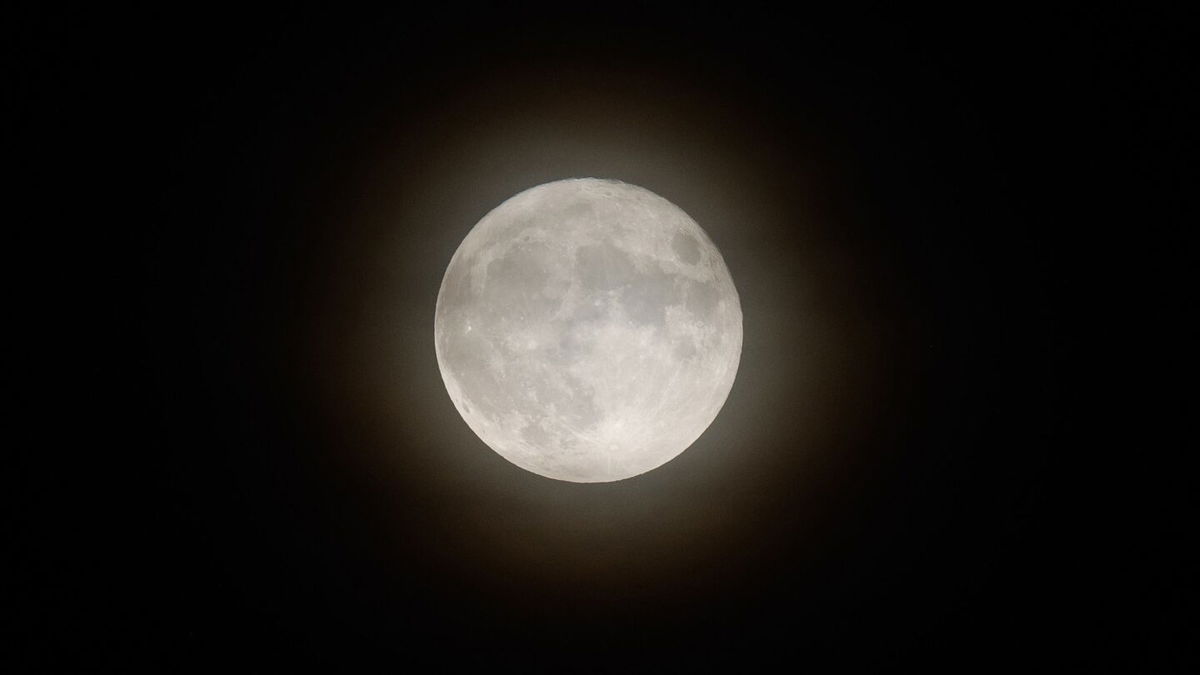The ‘blue moon’ won’t be the only rare sight in the night sky this week

By Ashley Strickland, CNN
(CNN) — August began with a bright supermoon and will end the same way as another one lights up the night sky this week. The ringed planet Saturn will also make its closest and brightest appearance of the year near the moon.
The full moon will peak at 9:36 p.m. ET on the evening of August 30, but will appear full through Friday morning, according to NASA.
At the end of evening twilight on Wednesday, around 8:42 p.m. ET, the bright glow of Saturn will appear about 5 degrees to the upper right of the moon. Over the course of the evening, Saturn will appear to move clockwise around the moon, according to NASA. At their closest, the two will appear to be about the width of four full moons apart, according to EarthSky.
Saturn reached opposition on August 27, when Earth moved between it and the sun, which means the ringed planet is at the closest point in its orbit to our planet and therefore visible in our night sky.
Both of the full moons in August can be considered supermoons, according to EarthSky. Definitions of a supermoon can vary, but the term generally denotes a full moon that is closer to Earth than normal and thus appears larger and brighter in the night sky. The moon will be 222,043 miles (357,344 kilometers) away from Earth, nearly 18,000 miles (28,968 kilometers) closer than its average distance.
Some astronomers say the phenomenon occurs when the moon is within 90% of perigee — its closest approach to Earth in orbit.
The supermoon may play a role in Hurricane Idalia, which is expected to make landfall Wednesday morning, by enhancing tides and worsening storm surge. Because of this supermoon’s proximity to Earth, its gravity will have a stronger effect on the oceans.
It could increase high tide by around a foot, according to National Hurricane Center Deputy Director Jamie Rhome.
The second full moon in one month is also known as a blue moon, like the phrase “once in a blue moon,” according to NASA. Just don’t expect it to take on a blue hue.
Typically, full moons occur every 29 days, while most months in our calendar last 30 or 31 days, so the months and moon phases don’t always align. This results in a blue moon about every 2.5 years, and the last one occurred in August 2021.
August’s second full moon also falls on the Hindu festival of Raksha Bandhan, which celebrates the bonds between brothers and sisters.
Full moons and supermoons
The fourth and final supermoon in 2023 will rise on September 29.
Here are the full moons remaining in 2023, according to the Farmers’ Almanac:
● September 29: Harvest moon
● October 28: Hunter’s moon
● November 27: Beaver moon
● December 26: Cold moon
Lunar and solar eclipses
People across North, Central and South America will be able to see an annular solar eclipse. During the solar eclipse, the moon will pass between the sun and Earth at or near its farthest point from Earth. The moon will appear smaller than the sun and encircled by a glowing halo.
To avoid damage to the eyes while looking at the phenomenon, viewers should wear eclipse glasses.
A partial lunar eclipse will also take place on October 28. Only part of the moon will pass into shadow as the sun, Earth and moon will not completely align. This partial eclipse will be viewable in Europe, Asia, Australia, parts of North America and much of South Africa.
Meteor showers
Each of the remaining meteor showers expected to peak this year will be most visible from late evening until dawn in areas without light pollution. Here are the events’ peak dates:
● Orionids: October 20-21
● Southern Taurids: November 4-5
● Northern Taurids: November 11-12
● Leonids: November 17-18
● Geminids: December 13-14
● Ursids: December 21-22
The-CNN-Wire
™ & © 2023 Cable News Network, Inc., a Warner Bros. Discovery Company. All rights reserved.






